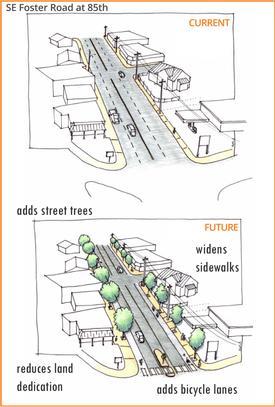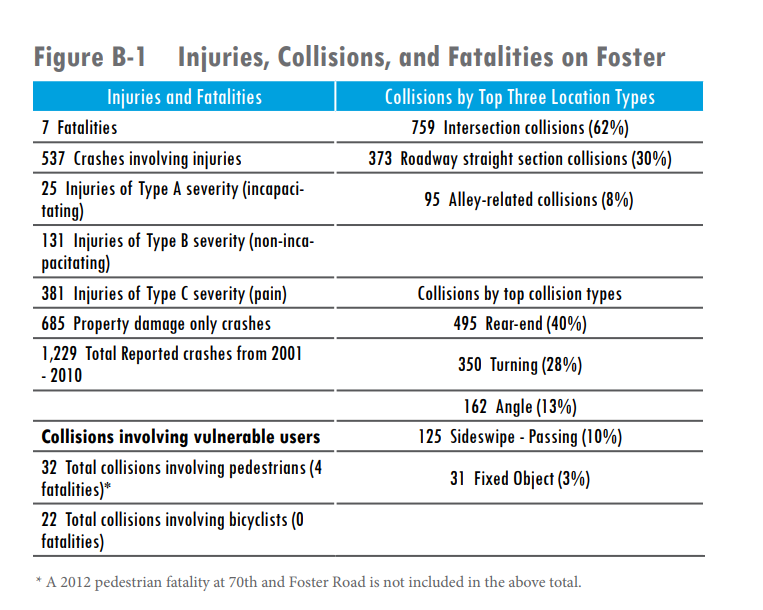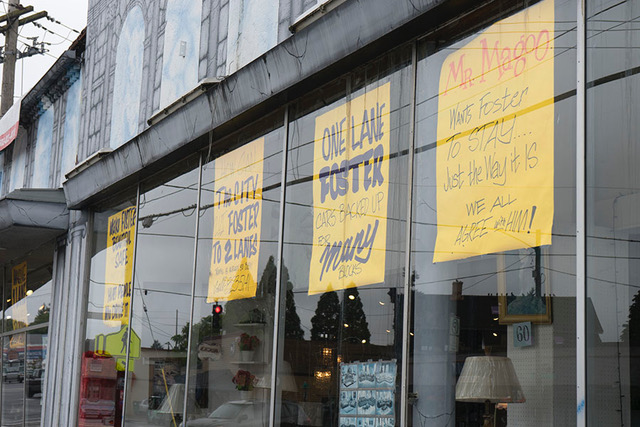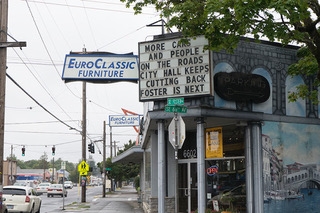Businesses debate pros and cons of development in the Southeast Portland neighborhood.
In 2011, Foster Road was identified as a High Crash Corridor with more than 1,200 crashes and eight fatalities — five of which were pedestrians.
Three years later, on June 11, 2014, the City Council unanimously approved an updated streetscape plan endorsed by the Foster Area Business Association (FABA). The project would slim down the four-lane Foster Road into a two-lane road with a center lane, bicycle lanes, wider street walks and more trees.

Courtesy of the City of Portland
Construction was slated to begin in 2015 but was delayed for logistical reasons. The City of Portland now anticipates construction will start by the end of this year or early 2018.
While many businesses support the development, others are unhappy with the changes. Over the past decade, the character of the neighborhood has started to shift away from legacy furniture and appliance businesses to restaurants, bars and trendy shops.
Varying attitudes toward the streetscape spotlight the divide between old and new businesses, as well as growing concerns about gentrification, traffic and rent increases in the Southeast Portland neighborhood.
Jon Shleifer, owner of Euroclassic Furniture, is one of the naysayers. His shop is plastered with bright neon signs opposing the project. “If Foster is important to you to go to work or home, call the mayor,” reads one sign.
But new businesses like Bread and Roses Market, hope the streetscape plan will attract more customers.
“One of the reasons I decided to open up the market in Foster is because of the streetscape project,” manager Sam Nayebi said. “It solidified my decision.”
HISTORY
The new streetscape plan is aimed at increasing pedestrian safety and boosting cyclist, pedestrian and transit access on Foster Road.
“It’s important for people to understand that four-lane road presents what’s called a double threat,” said Steve Novick, a former Portland commissioner who helped spearhead the plan. “A pedestrian might start walking across the street when they see that the driver of the car in the lane next to the sidewalk has seen them and slowed down — but the driver in the next lane hasn’t seen them, and hits them as they cross into that second lane.”
PBOT expects the new cross-section that extends from SE 54th to SE 90th avenues to reduce all types of crashes by at least 20%.

Courtesy of the City of Portland
The streetscape project also aims to make the street more pleasant, and attractive by adding more trees, street lighting and other improvements, such as widening islands for more convenient transfers and more bus shelters. The goal is to get more people to wander the streets.
“Maybe people would be driving a little slower and notice some the great businesses that are on the street and decide to stop and eventually shop,” said Matthew Micentic, president of the Foster Area Business Association and co-owner of Red Castle Games.
NEIGHBORHOOD RESPONSE
The Foster-Powell Neighborhood Association (FPNA) has been fighting for two decades to get the city to improve safety on Foster Road. But businesses and residents disagree on how to make the streets safer.
“Some of our neighborhood’s biggest challenges are safety in our public spaces and our roads,” said FPNA Chair Brian Balla.
Bob Tousignant begs to differ. He owns a few residential and commercial properties in the neighborhood. He said that the growing number of accidents happening in Foster each year correlates with the amount of bars and clubs emerging in the area.

Asked about FABA’s endorsement of the plan, Tousignant and Shleifer said the association was not representative of the neighborhood business community.
“Almost everyone who participates in the association has only been in business a very short time,” said Shleifer. “But the businesses who have been here for many decades are not involved.”
TRAFFIC CHANGES
According to PBOT public information officer Dylan Rivera, the new development will not increase traffic— except during the afternoon peak hours. Traffic is expected to increase by three minutes. See chart below.
“I don’t think that (the delay) is insignificant,” Novick said. “What I asked people, though, was that wouldn’t you be willing to volunteer two-three minutes a day of your time to make your community safer for children?”
Tousignant said drivers will use inside streets as alternative routes, making it more unsafe for children walking in the residential areas.
“Cutting a four-lane to a two-lane and trying to carry the same amount of traffic, common sense says it just doesn’t work,” Shleifer told KATU News. “I’ve been waiting for 30 years for improvements, but keep the four lanes because it’s a major highway.”
Shleifer also said that adding a bicycle lane in a busy street would be dangerous.
Rivera said that traffic should slow down, making it easier and safer for people to cross when shopping or walking to school.
GENTRIFICATION
The Foster-Powell area has long been a working-class neighborhood home to residents from diverse backgrounds.
But the neighborhood is changing. Balla said key issues facing the neighborhood are the rising cost of housing “and how (the) neighborhood can grow in a way that is sustainable and meets the needs of all residents.”
“The change in housing costs seem to be driven by an influx of new residents to the Portland area and long-time Portland residents who are moving to the neighborhood in search of more affordable housing,” Balla said. “Our goal is to see Foster-Powell continue to be a place that uplifts our neighborhood’s diverse residents. It’s our core belief that our neighborhood’s vibrancy goes hand-in-hand with its affordability and accessibility.”
Current LNA Transportation Chair Christo Brehm said that while there are clear benefits anticipated with the project there are also unintended consequences that could potentially harm residents and businesses.
“There is an expectation that these roadway and land use changes will bring new vitality to businesses in the area, increase commercial and residential property values and help the neighborhood grow as an attractive multi-modal hub within the Portland Metro Area,” Brehm said in an email. “But on the land use side, commercial and residential owners and tenants may be priced out and displaced.”
“We’re doing our best in the business association to make sure that everyone is aware and try to negotiate long-term leases,” Micentic said. “We have this great mix in Foster of new and old businesses, so we need to make sure that the mix is maintaining itself.”
Tousignant is skeptical this will happen. “They intend to gentrify and turn Foster into another Hawthorne,” he said. “I think they want to get more tax revenue out of this area, because (Foster) has one of the most reasonable prices in Portland. They want to bring that up and force all the working people out.”
Former Lents Neighborhood Association President Nick Christensen, a representative on the transportation project committee, said the Foster Road redesign would lead to increased travel times and “raised serious equity concerns with PBOT’s implementation of road diets.”
“East Portland already had the longest commutes in the region,” he said. “PBOT insisted that the lane reduction would result in ‘just three more minutes of delay each way’ on top of the other delay projects they’ve done in Division, Naito, Glisan, and other major arterial roads.”
Novick said the focus should be on the number of crashes and fatalities along the corridor.
“I don’t think that you should keep a street dangerous because of these concerns,” Novick said. “We can address inequality in ways other than making people take their lives in their hands when they cross the street.”
Micentic said Clay Tyler, owner of Mt. Scott Fuel, worried that one of the crosswalk placements would make it difficult for trucks to enter and exit the property. Tyler reportedly plans to sell his property.
“I hate to see this street, one of the last transportation corridors, destroyed,” Tyler told The Oregonian. “I want Portland to be beautiful, but I hate to see this made into a ‘pretty’ street.”
But with new businesses emerging in the corridor, old businesses are spotting a disadvantage.
“We see a long-term benefit to having more neighbors within walking distance,” said Shea Flaherty Betin, community coordinator for the Portland Mercado, a Hispanic market that opened a couple of years ago. “Business has finally reached a good stable plateau for us, and we definitely expect the development to bring more regular customers in the coming years.”
Rachel Ramirez is an Oregon Business intern.



